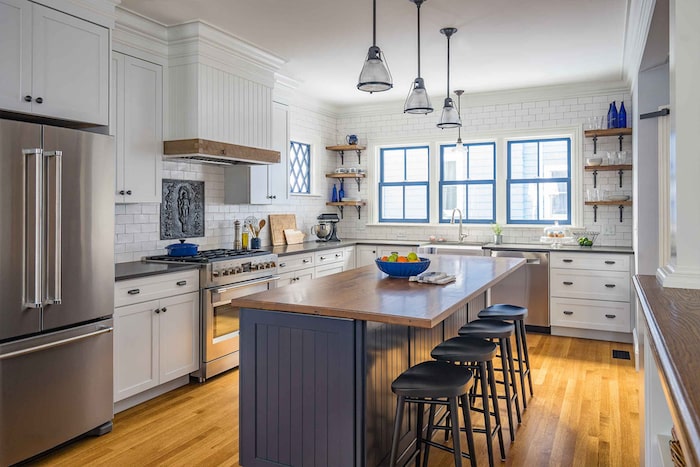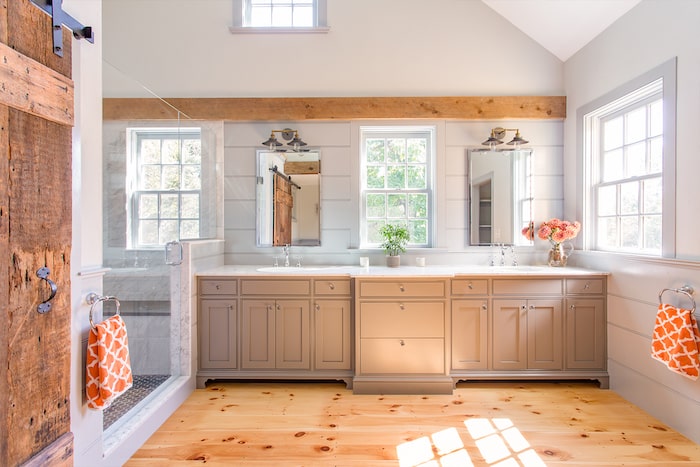
Even though we get to spend every day soaking in the fun of design and architecture, we still love catching up on some HGTV on the weekends. Hometown is an office favorite. It’s a guilty pleasure, though, because we know exactly how different these shows are from the real-life experience of designing a home.
It’s SO different. Like entirely different worlds. It’s reality TV versus reality.
For people who love watching HGTV, it can be a bit of a surprise that real-life projects don’t happen exactly the same way.
We wanted to explain what causes those differences between HGTV and real life so those of you considering a future home project can have some of your questions answered.
It’s time to pull back the curtain on HGTV…
What’s a Realistic Timeline?
When you’re watching Property Brothers or Fixer Upper or any of your favorite HGTV shows, it’s pretty common to watch a whole project start-to-finish in a single hour-long episode. While we all know that’s thanks to the magic of video editing, these shows are often produced on a six-to-eight week schedule. That’s design and construction completed in two months. Most of those projects would take six-to-twelve *months* on a real-life schedule.
So, how is HGTV able to get them done in a quarter of the time? There are a few things to consider.
Scheduling Construction Trades
TV shows have huge crews. They bring all the trades together to work on the house at the same time, and sometimes they’re working 24-hours a day. In reality, construction crews can’t work 24-hours-a-day and all the trades won’t be on-site together at the same time. They have other clients and projects to work on, so they need to schedule their work. Most construction firms have smaller crews, too, so on-site work will take longer.
Ordering Products
As design decisions are made, product manufacturers all have lead times. Some are shorter than others, but it takes time to order products and have them delivered. Television shows can get companies to speed up production and delivery times because they want their products featured in the show. Whoever can deliver faster has a better chance of being highlighted in the show. Unfortunately, the rest of the design world doesn’t have the same kind of influence.
Building Approvals
Every construction project requires building code approvals. They have a standard process and scheduled review meetings. We work with their schedule and process if we want to get approvals. However, building code departments are very accommodating to television studios, and the normal approval process gets heavily expedited.
Meetings and Design Decisions
As a homeowner, your deadlines are probably at least somewhat flexible. Project meetings can be scheduled around important work meetings, social functions, and vacations. Design decisions will sometimes wait until after a busy work week. But television deadlines aren’t flexible. Their schedule is set in stone, based on air dates and marketing timelines. Nothing gets pushed or shifted.

Loose Ends in the Punch List
At the end of a show when the homeowner moves back in and everything looks perfect? It’s not usually perfect. The cameras don’t show us the punch list items that remain and still need to be addressed. After the last camera crew has left the site, the construction crew returns later to make final repairs and adjustments. So even when the show is over, the project isn’t totally complete.
So what is a realistic schedule? Well, it truly depends on what you want to accomplish. Many people are surprised that our design work can happen as quickly as you’d like. But often scheduling conflicts and design decisions lead to delays, so most projects take six-to-twelve months from start to completion. They can be shorter or longer, but we’ll work with you to make sure the schedule happens at a pace that you’re comfortable with and that works for your personal goals and life.
What Does a Real Project Cost?
Comparisons to HGTV projects often come up when we’re talking to potential clients about budget. Most people know that HGTV budgets aren’t realistic – renovating half a house including a kitchen and baths for $100,000 sounds unrealistic – but they’re still hoping it could be a reality for them. But here’s what makes a huge difference in budgets between HGTV and real life: HGTV has geography and brand sponsorships on their side.
Geography Cost Differences
Have you noticed that many HGTV shows are filmed in Texas, Florida, or a small town in another lower-cost area? There’s a big reason for these locations – cost. If you’re living in an area where you can buy a house for $30,000, the price you’ll pay for renovations will be priced accordingly. However in areas like New England where we’re located, or other metropolitan areas, property prices and construction costs are much higher. There are many factors that relate to geographic cost differences, including:
- Construction materials
- Labor
- Construction codes and styles (depending on the regional environment, weather, etc.)
- Insurance
- Overhead
Many of these costs vary widely between different geographic regions. HGTV chooses it’s site locations carefully, and budget is a big factor.

Brand Sponsorships
Earlier in this post, we mentioned the impact of product delivery timelines. Product manufacturers also have influence on a show’s budget because it’s common for large brands to pay to have their products featured on a show. So if you notice a lot of decor from Target or TJMaxx featured in an episode, it’s probably because the stores paid HGTV a lot of money to be featured. Or they provided products for free (or heavily discounted).
When major brands provide funding or donate product to HGTV shows, it allows the shows to keep their budgets way down. However, this also means that the homeowners don’t have ultimate control over the products that are placed in their home. They may get a look that’s similar to what they want, but a sponsored product will need to be used.
Where is the “Reality” in HGTV?
Reality TV shows are supposed to be based in reality, but we all know they’re scripted, financed, produced, and edited. They’re not “real” reality. But there must be something about HGTV shows that is similar to real home projects, right? Yes, and that’s exactly why we love them too. What goes on in construction is very real. The demo, the unexpected issues, the amazing feeling when you start to see it all coming together – all of that is very real.
If you’d like to watch a more realistic portrayal of home design projects, This Old House is a good option. It’s still television, so it’s not exactly like a real-life project. But it’s as close as you’ll see on TV – the budgets and timelines are often very realistic, and you’ll spend a whole season watching Kevin O’Connor and the contractors working on a single project from start through completion. We loved our experiences working with This Old House on our Newton project and the Belmont Victorian.
